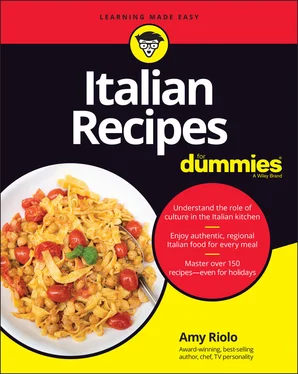The Role of Culture in the Italian Kitchen
Food is such an integral part of Italian culture — regardless of the region — that it is impossible to speak of one without the other. One of the reasons why Italian food is so appreciated internationally is that Italians understand and respect its place in culture. It has been said that food is art, nutrition, philosophy, diplomacy, spirituality, science, medicine, culture, joy, spirit, and entertainment. In the case of Italian food, this is especially true and realized by the locals.
No one in Italy is ever accused of speaking about food “too much” or called “a foodie.” Instead, a buona forchetta, or “good fork,” is used to describe a person who appreciates good food (as they rightly should), and it’s a compliment. Throughout history, we see the use of food in pagan culture, through antiquity, in Christianity, and now in our modern world with an almost sacred (and rightly so) appeal. The food we consume is one of the most powerful tools we have to affect our personal health and happiness. Prior to the 20th century, it was the philosophers and physicians who wrote about food, not the chefs themselves, which underscores the importance of the topic of cuisine. From Pythagoras’s teaching of nutrition in Kroton (Crotone), to Apicius writing the first Roman cookbook, to the scholars of the Middle Ages to Pellegrino Artusi’s 19th century writing classic, we can witness food being a highly appreciated form of culture.
Culture, in the Italian kitchen, is the knowledge that traditions were created for specific reasons (religious, seasonal, in commemoration of events); to recreate a recipe as it was customarily done is to promote the heritage of a particular region. In addition to the pleasure of eating mouthwatering specialties, this desire to uphold culture is the base of Italian cuisine. In many instances in the kitchen, shortcuts can be taken to save time and money. A true Italian cook, however, always opts for the traditional option, when possible, because they realize that losing customs is too great a price to pay and that spending a few moments to pass down heritage is time well spent.
Touring Important Events in Italian Culinary History
It’s important to understand that Italy’s long and varied culinary history deserves semesters of study. The overview in this section offers just enough info to whet your appetite for the history of Italian food and to enable you to appreciate just how diverse it is. Wheat and wine, for example, are two cornerstones of both ancient and modern Italian cuisine that originated in Mesopotamia, the area that is now modern-day Iran and Iraq. The Romans made the most significant contributions to the development and spread of viticulture, the study of grape cultivation, around the Mediterranean. Today, as a result, Italy is the largest producer of wine in the world. The Roman goddess of grain, Ceres, gave grains their common name today “cereal,” which in Italian are called cereali.
Most English-language history books begin discussing Italian history with ancient Rome. Prior to the Romans, however, there were native inhabitants and foreign powers in the various areas that now make up modern Italy. Each of those tribes, of which only some are mentioned here, already had laid the framework for the cuisine of their regions. The Lucani, for example, were from modern-day Basilicata, which is believed to be home to the first human settlements in Italy. Many of their agricultural practices, including animal husbandry and cheese-making traditions, are still being practiced today. Indigenous ingredients such as herbs, pulses, meat, seafood, and grains are still part of the daily diet in this region.
From the Celts in the extreme North, to the Etruscans in modern-day Tuscany and Lazio, the Samnites in what is now modern-day Abruzzo and Molise, the Apulians in Puglia, the Sicani in Sicily, the Umbrians in Umbria, some Carthaginians, in addition to the Greeks in Sicily, the Sardi in Sardinia, and the Itali and the Oenotri in my ancestral homeland of Calabria, even regional Italian cuisine has a multitude of ancient influence. The word Italy actually takes its name from the Itali tribe, and the word oenotria, or “land of trained vines,” was given to Calabria by the Greeks, who called the area’s inhabitants Oenotrians (vine cultivators). Calabrian wine, in fact, was so revered by the ancient Greeks that they served it during Olympic ceremonies in Greece.
How Romans and Greeks laid the foundation for Italian cuisine
The Greeks considered Southern Italy, from Naples south, to be the promised land. From the eighth to the fifth centuries B.C.E., they began populating the entire region, beginning with the Italian island of Ischia. For this reason, there are more Greek monuments in Sicily today than there are in modern Greece, and the regions of Southern Italy became known as Magna Graecia, or “Greater Greece.” The fertile land, access to additional trade routes, and beautiful terrain inspired the Greeks to set up polis , or city states, in Coastal Greek towns.
Napoli was one of the main cultural centers as were modern-day Reggio Calabria and Crotone, along with many others. The Greeks set up monuments to their gods. Even the Greek philosopher and Mathematician Pythagoras set up his school of mathematics, nutrition, philosophy, and music in Kroton, now called Crotone, Italy. An old adage says “When the Romans were still poor shepherds, Pythagoras was teaching in Crotone.” These Greek influences did leave a footprint on the cuisine of the Italian south. Pythagoras, for example, was a strict vegetarian and asked his disciples to give up meat in order to study with him. Greek herbs and spices such as oregano, anise, and eucalyptus became widely used. Manners of preparing meat and wine varieties, such as Greco and Aglianico, for example, came directly from Greece.
When the Romans came into power, they did not want to turn their backs on Greek cultural traditions, which they greatly respected, but rather build upon them. Many Romans went to Naples to experience the Greek way of life. The Roman philosopher Virgil was known for saying that Naples was, in fact, a city where one could live and die in the manner of the Greeks. Even Roman emperors and public figures recited plays in Greek when performing and presenting at amphitheaters in Naples, since it was a Greek speaking city at the time.
Romans improved upon Etruscan and Greek wine-making and culinary techniques and began introducing both olive trees and vines to Gaul (modern-day France) and other areas in the empire. The Romans set up a network of trade that spanned from the modern-day United Kingdom, through Western Europe, into North Africa, the Middle East, Central Asia, and China. Sometimes, they used existing trade routes such as the Silk Road, the Incense trails, and those set up by the Vikings; other times, they constructed their own routes.
Regardless of which routes they used, Roman commerce set up a sophisticated structure of international commerce that we now refer to as globalization. Roman Emperors sent fleets out to various areas of the globe to procure the best ingredients. They knew, for example, when the best prawns were available in the Mediterranean and sent ships to fish for them off the coast of Libya. They procured enough wheat from North Africa to fund the entire empire. Elaborate murals and depictions from Pompei provide a glimpse into the daily lives of ancient Romans, the ingredients they had at their disposal and how they cooked and shopped.
Spiced wine, or mead, along with barley and wheat bread, grains and pulses, fresh fruit (figs, pomegranate, apples, grapes, quinces, and dates) and vegetables (cucumbers, lettuce, leeks, greens, broccoli, onions, and garlic) along with legumes such as chickpeas and fava were prepared in addition to poultry, foul, and meat by the ancient Romans. Food was heavily spiced because spices were a symbol of wealth and luxury as well as traditional medicinals. Roman cuisine is most often depicted using garum (a fermented fish sauce) as a condiment. The Romans taxed citizens heavily on salt and wheat, so they invented ingenious ways of flavoring food (such as with preserved fish) and mimicking a staple grain (such as burning the grain that came out of winnowers and grinding it again by hand, known as grano arso , or “burnt grain” in Italian).
Читать дальше












